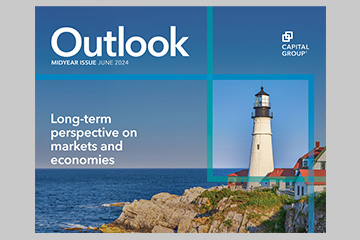Market Volatility
Bonds
Many investors turned to bonds in early 2024 in search of that sweet spot between high income opportunities and protection from equity market swings. Although persistent inflation may have dampened the mood, the outlook for bonds remains promising. This is particularly true as markets have slashed their expectations for rate cuts to align more closely to the Federal Reserve’s forecast.
“Bond investors were too exuberant about rate cuts at the start of the year, but now that markets aren’t aggressively priced for cuts, yields in fixed income are more attractive,” says Vince Gonzales, portfolio manager for Short-Term Bond Fund of America®. Bonds remain critical as economic growth slows and can provide a strong counterweight to stock market volatility.
At the June meeting, Fed officials kept the benchmark interest rate unchanged at a range of 5.25% to 5.50%. The central bank guided to a single rate cut by the end of 2024, with borrowing costs expected to decline to 5.1%. Officials plan to make four rate cuts in 2025, up from prior projections of three, with rates anticipated to end 2025 at 4.1%.
The hyperfocus on Fed policy is understandable given its outsized influence on bond returns: History shows that bonds have tended to rally once the Fed stops hiking. “Still, it’s difficult to time markets and investors don’t want to miss the forest for the trees,” Gonzales notes, adding that “the bar for the Fed to hike from here is high, and after decades of low rates income is here.”
Rate cuts are on the horizon

Sources: Capital Group, Bloomberg, Federal Reserve. Fed funds target rate reflects the upper bound of the Federal Open Markets Committee's (FOMC) target range for overnight lending among U.S. banks. Median Fed projections are as of June 12, 2024. Latest data available as of June 12, 2024.
What’s next for interest rates?
Inflation, the Fed’s response, and a remarkably resilient U.S. economy have humbled many investors.
“The economy continues to hum along despite higher rates,” says Tim Ng, portfolio manager for American Funds® Strategic Bond Fund. “At the same time, there continues to be evidence that demand has softened, particularly in the lower income cohorts. That bears watching.”

Source: Capital Group.
Preparing bond portfolios for a range of outcomes is vital since ever-changing data will continue to create uncertainty. For example, inflation fell rapidly in 2023, but recently proved to be stickier than expected. Coupled with solid economic data, the higher-for-how-much-longer debate is expected to remain a hot topic.
“The first Fed cut is generally viewed as the start of a series, so policymakers want to be sure conditions are right for them before they embark on that next step,” Ng says.
Investors have revised their outlook on interest rates upwards, with the 10-year U.S. Treasury at 4.50% on May 31, 2024, compared to its level of 3.88% at the start of the year. Ng believes that Treasury yields are likely to remain range bound since Fed officials largely view the current policy rate as restrictive. Assuming inflation continues to fall closer to the Fed’s 2% target, the central bank appears biased toward rate cuts.
Treasury yields could break out of their range if a sharp economic slowdown prompts deeper cuts or, conversely, a dramatic upswing in inflation forces the Fed to shift back to rate hikes. Ng hasn’t ruled out either but considers both unlikely in the near term. Growth slowed in the first quarter with revised U.S. GDP, adjusted for inflation, growing at a 1.3% annual rate compared to 3.4% in the final quarter of 2023, according to the Commerce Department.
Many members of the fixed income team have high conviction around positioning portfolios for a steeper yield curve, meaning they expect long-term Treasury yields to surpass short-term yields. That’s because the curve could steepen if the economy hits a rough patch, or in an environment where rates stay high for an extended period, explains Ng. In the latter, short-term yields would remain anchored while long-term yields rise.

Midyear Outlook webinar
Watch it on demand
Mortgage bonds offer potential value
As the economy has chugged along and demand from investors has remained strong, the spread, or yield differential, between credit assets and U.S. Treasuries has narrowed significantly. As such, the greater return potential for bonds with credit risk comes not from possible spread tightening, but a decline in interest rates.
“Given the recent tightening in corporate bond spreads, we are seeing better opportunities in higher quality sectors with attractive yields such as securitized credit and agency mortgage-backed securities (MBS),” Gonzales says. Higher coupon mortgage bonds are particularly attractive. These bonds are unlikely to get refinanced ahead of their maturity given prevailing mortgage rates of roughly 7%.
Supply dynamics also work in their favor. Namely, home sales have slowed as homeowners decline to sell, clinging to pandemic-era mortgage rates.
“Exposure to agency MBS can help investors maintain a balanced portfolio alongside credit opportunities,” Gonzales says. History has shown that credit spreads have stayed at these levels for a long time, especially if the economic outlook points toward continued growth.
Resilient economy has supported tight spreads over Treasuries

Sources: Capital Group, Bloomberg Index Services Ltd. Yield to worst is a measure of the lowest possible yield that can be received on a bond that fully operates within the terms of its contract without defaulting. Spread to worst is the difference between the yield to worst of a bond and yield to worst of its benchmark yield curve. Indexes used are the Bloomberg U.S. Corporate Investment Grade Index (U.S. investment grade), Bloomberg U.S. Mortgage-Backed Securities (MBS) Index (mortgage-backed securities), Bloomberg U.S. Asset-Backed Securities Index (asset-backed securities) and the Bloomberg U.S. Corporate High Yield 2% Issuer Capped Index (U.S. high yield). As of May 31, 2024. Past results are not predictive of results in future periods.
Healthy fundamentals support corporate bonds
Despite tight credit spreads, steady consumer spending and economic growth translate to solid income potential for corporate investment-grade (BBB/Baa and above) and high-yield bonds in 2024.
Corporate issuers have largely avoided the impact of high financing costs because most refinanced their debt during the pandemic when rates were near zero. A strong consumer also enabled businesses to increase prices for goods and services. Earnings growth is likely to remain positive through 2024 and 2025.
But so long as the yield on 10-year Treasuries stays near 5%, risks remain that economic cracks could develop. This is especially true if companies are forced to renew their debt at higher costs, a process expected to begin over the next two years.
Risks tied to high rates warrant a cautious approach, especially when it comes to lower rated bonds.
“In high yield, there are attractive opportunities in certain defensive sectors, like energy, that have strong balance sheets and can withstand higher rates and weaker economic growth,” says David Daigle, principal investment officer for American High-Income Trust®. On the opposite end of the risk spectrum, there are idiosyncratic investment opportunities among companies finding it more challenging to adapt to higher rates.
Bonds now offer the highest income potential in 23 years, which might explain why spreads remain so narrow. “Starting bond yields are a good indicator of future annualized return, and today’s levels are attractive by long-term standards,” Daigle concludes.
Emerging market yields remain attractive
While headline inflation has ticked up in several emerging markets recently, core inflation remains muted. This is thanks to aggressive actions by central banks early in their inflation cycles.
Many emerging economies shifted toward easier monetary policies when inflation softened, but there are regional differences. While most Asian economies are not yet ready to reduce rates, with Indonesia recently raising rates, several Latin American and Eastern European countries are well into their easing cycles.
That said, sustained U.S. dollar strength and expectations of fewer rate cuts by the Federal Reserve this year have diminished the scope for further monetary easing. On the positive side, an improving global growth outlook is helping offset the impact from higher U.S. Treasury yields.
Economic growth rates for several developing economies continue to outpace their developed market counterparts, with similar fiscal deficits and mostly lower sovereign debt levels. Likewise, commodity prices have supported emerging market external balances and reserves.
We remain largely constructive on emerging markets debt. “Valuations are reasonably attractive in local currency markets with high real rates,” says Kirstie Spence, portfolio manager for American Funds Emerging Markets Bond Fund®. “In U.S. dollar-denominated debt there are opportunities in higher yielding credits where wider spreads offer a valuation cushion. Select EM corporate bonds add diversification given different geographies and risk structures relative to sovereign bonds.”
Delayed rate cuts may not be so bad for munis
Municipal bond investors frustrated by the Fed’s delayed rate cuts might want to consider the bright side of stable interest rates: attractive income. For those in moderate to high income tax brackets, the muni market offers compelling after-tax yields. At the highest bracket, the tax-equivalent yield for the Bloomberg Municipal Bond Index was 6.4% in April, compared to 5.3% for the taxable Bloomberg U.S. Aggregate Index.
Investors don’t have to sacrifice quality for attractive income. That’s because the difference in yields between high- and low-rated bonds has compressed.
“Many of our portfolios lean relatively higher quality, which may provide better resilience should the economy weaken,” says portfolio manager Mark Marinella, portfolio manager for CGMU — Capital Group Municipal Income ETF. Fundamentals remain strong among states and other general obligation issuers, but bonds supported by revenue-generating projects are often more attractive. “You can more easily track and monitor revenue bonds, whereas general obligation bonds issued by states and municipalities can be subject to political risk,” he notes.
Investors nervous about an extended delay in cuts could rebuild a bond allocation starting with shorter term maturities. “I expect the muni yield curve to normalize following the Treasury curve, which could provide investors a strong signal for when to add more interest rate exposure,” he adds.
Investors are being paid relatively less for more risk

Source: Bloomberg. Data as of May 31, 2024. AAA represents the Bloomberg Municipal AAA Index, which is a subset of AAA bonds from the Bloomberg Municipal Bond Index; BBB represents the Bloomberg Municipal BAA Index, which is a subset of BBB bonds from the Bloomberg Municipal Bond Index; and high yield represents the Bloomberg High Yield Municipal Bond Index. Past results are not predictive of results in future periods.
Why it’s time to revisit bonds
The crosscurrents of inflation, rising stocks and tight valuations have caused uncertainty in bond markets. But with the Fed likely done with interest rate increases, many investors have returned to bonds. Concerns around consumer spending will continue as growth slows. Whether momentum in stock markets can last is also a valid concern.
“The current environment of slowing growth can be a good backdrop for bond returns,” Gonzales says. “Even if the Fed doesn’t lower rates, investors can generate attractive income in high-quality bonds.”
As nondiversified funds, Capital Group ETFs have the ability to invest a larger percentage of assets in securities of individual issuers than a diversified fund. As a result, a single issuer could adversely affect a fund’s results more than if the fund invested a smaller percentage of assets in securities of that issuer. See the applicable prospectus for details.
Past results are not predictive of results in future periods.
Investing outside the United States involves risks, such as currency fluctuations, periods of illiquidity and price volatility, as more fully described in the prospectus. These risks may be heightened in connection with investments in developing countries.
The return of principal for bond funds and for funds with significant underlying bond holdings is not guaranteed. Fund shares are subject to the same interest rate, inflation and credit risks associated with the underlying bond holdings. Lower rated bonds are subject to greater fluctuations in value and risk of loss of income and principal than higher rated bonds. Income from municipal bonds may be subject to state or local income taxes and/or the federal alternative minimum tax. Certain other income, as well as capital gain distributions, may be taxable. While not directly correlated to changes in interest rates, the values of inflation linked bonds generally fluctuate in response to changes in real interest rates and may experience greater losses than other debt securities with similar durations. The use of derivatives involves a variety of risks, which may be different from, or greater than, the risks associated with investing in traditional cash securities, such as stocks and bonds. Bond ratings, which typically range from AAA/Aaa (highest) to D (lowest), are assigned by credit rating agencies such as Standard & Poor's, Moody's and/or Fitch, as an indication of an issuer's creditworthiness. If agency ratings differ, the security will be considered to have received the highest of those ratings, consistent with the fund's investment policies.
Investments in mortgage-related securities involve additional risks, such as prepayment risk.
The market indexes are unmanaged and, therefore, have no expenses. Investors cannot invest directly in an index.
Bloomberg U.S. Aggregate Index represents the U.S. investment-grade fixed-rate bond market.
Bloomberg U.S. Corporate High Yield 2% Issuer Capped Index covers the universe of fixed-rate, non-investment-grade debt. The index limits the maximum exposure of any one issuer to 2%.
Bloomberg U.S. Corporate Investment Grade Index represents the universe of investment grade, publicly issued U.S. corporate and specified foreign debentures and secured notes that meet the specified maturity, liquidity and quality requirements.
Bloomberg U.S. Mortgage Backed Securities Index is a market value-weighted index that covers the mortgage-backed pass-through securities of Ginnie Mae (GNMA), Fannie Mae (FNMA) and Freddie Mac (FHLMC).
Bloomberg U.S. Asset-Backed Securities Index is a broad-based flagship benchmark that measures the investment grade, U.S. dollar-denominated, fixed-rate taxable bond market. The index only includes ABS.
Bloomberg Municipal AAA Index is a market value-weighted index representing the AAA-rated portion of the Bloomberg Municipal Bond Index.
Bloomberg Municipal BBB Index is represented by the Bloomberg Municipal BAA Index. Bloomberg Municipal Bond BAA Index is a market value-weighted index representing the BAA-rated portion of the Bloomberg Municipal Bond Index.
Bloomberg High Yield Municipal Bond Index is a market value-weighted index composed of municipal bonds rated below BBB/Baa.
BLOOMBERG® is a trademark and service mark of Bloomberg Finance L.P. and its affiliates (collectively “Bloomberg”). Bloomberg or Bloomberg’s licensors own all proprietary rights in the Bloomberg Indices. Neither Bloomberg nor Bloomberg’s licensors approves or endorses this material, or guarantees the accuracy or completeness of any information herein, or makes any warranty, express or implied, as to the results to be obtained therefrom and, to the maximum extent allowed by law, neither shall have any liability or responsibility for injury or damages arising in connection therewith.
Our latest insights
-
-
Market Volatility
-
Market Volatility
-
-
Artificial Intelligence
Get the 2024 Midyear Outlook report
Never miss an insight
The Capital Ideas newsletter delivers weekly insights straight to your inbox.
 Vince Gonzales
Vince Gonzales
 Timothy Ng
Timothy Ng
 Mark Marinella
Mark Marinella
